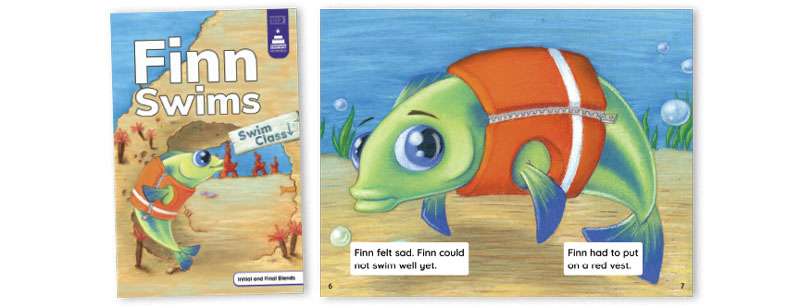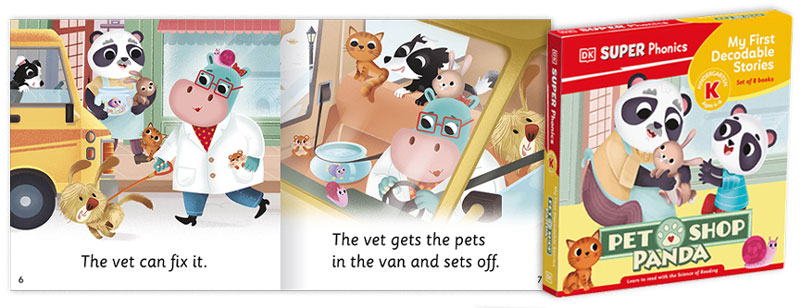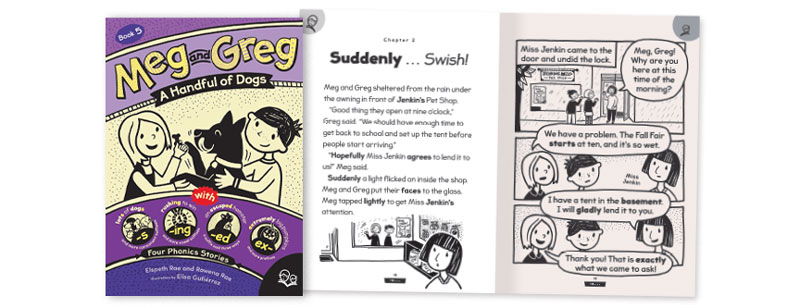Support Classroom Literacy with Decodables
As reading instruction swings toward phonics, librarians need to stay in the game with decodables. These suggestions, plus a sampling of publishers' offerings, will help.
 |
Finn Swims courtesy of Capstone |
In this Article——— Related reading: |
As reading instruction swings toward phonics-based practices, many educators will tell you that meeting the science of reading framework requires specific materials. Decodable books—also known as decodables, decodable texts, or decodable readers—are the go-to reading materials directly related to phonics instruction and practice, given their composition and features designed for beginning readers.
The average decodable has small dimensions that fit well in young learners’ hands, along with soft covers and thin bindings that hold 12 to 16 pages together. Put simply, decodable books are light, bright, and unassuming. These effective vehicles invite beginning readers to dive into books while offering achievable challenges as students master growing skills.
While decodables circle around fiction or nonfiction topics, these works are written to apply a specific phonetic focus, usually in direct association with weekly ELA learning objectives for students in kindergarten, first grade, or second grade.
For example, a decodable may focus on the short “o” sound, offering simple sentences dotted with short “o” words in CVC (consonant-vowel-consonant) spelling patterns and high-frequency words. Consider “Stop! The hog sat on the log with a dog.” Or, a phrase may feature different letter combinations that create the long “u” sound: “Did you see who drew the blue tube?” Sentences like these provide crucial reading practice for students to translate written language into verbal speech sounds.
The story in a decodable may not follow a plot sequence or offer an informative tale. And while decodable readers feature illustrations, the pictures aren’t meant to distract the students from their goal to tackle—to sound out, to decode—the words.
Keri Harvey, a certified reading specialist and kindergarten teacher at a Title I elementary school in New Jersey, describes how her students learn to interact with decodables. “As we read a book together, I think aloud to model for the students how to sound out difficult words,” she says. “I tell them that when they come to a word they don’t know, they can sound it out just like me.”
Harvey scatters decodable readers around the classroom’s block center, dramatic play area, toys and games center, and art area so kids come across them on their own. She says, “The students are so proud when they begin to realize they can read!”
 |
Pet Shop Panda materials courtesy of DK |
Accessibility and information
As decodable offerings expand, certain factors pose challenges to librarians seeking to engage with them. Decodable readers are an unusual format to maintain and classify. Some librarians don’t try to. “Our library collection is not leveled, but curated and displayed in a way that students want to check out library books each and every week,” says Jennifer Latimer, media specialist at Clinton Elementary School Library in Maplewood, NJ. “I encourage students to find books that excite them even if they cannot actually read the book.”
Decodable series or sets are particularly expensive, and librarians and teachers alike often encounter sparse information from vendors about the relevance or content of selections.
“Librarians who want to incorporate decodable books still have to do much of the legwork themselves,” says Elizabeth Crispino, Media Specialist at Walter C. Black Elementary School in Hightstown, NJ. “Most of our vendors do not list any information about what skills are targeted in each title, most decodables are available only in flimsy paperbacks, and there is still a lot of confusion up to the publisher level in how decodables are different from leveled readers. It’s hard to know exactly what you’re getting until it arrives.”
Some decodables, like Houghton Mifflin Harcourt’s Journeys, are available either in a physical or printable format. Others are downloadable from vendor or teacher-made resource sites, such as Teachers Pay Teachers.
As a former first grade teacher and K–2 assistant, I relied on teacher-created resources, donated decodables from colleagues, and decodable sets I could afford through vendors’ points systems. With these limitations, the quantity and quality of decodables in my classroom didn’t meet students’ demand or my goal to provide enough independent reading material for our weekly phonics objectives.
While librarians historically have had differing opinions about phonics, Crispino sees the approach playing a key role in children’s enthusiasm for reading. “When it comes to the argument that librarians should be fostering a love of reading, I agree wholeheartedly,” Crispino says. “But I’ve seen that a love of reading develops down multiple paths. It develops on the lap of a loved one, and then sitting in a circle listening to a read-aloud. But it also develops as students build their own concrete skills and feel the satisfaction of mastering something that initially seemed so foreign and inaccessible. Decodable books allow readers to develop that confidence—just watch a child successfully read their first book where they’ve cracked the code behind the words and you’ll see it.”
I have witnessed many such “aha!” moments: when a student proudly held out a stack of decodables and stated, “I read them all!” or when two students sat on the floor passing a decodable back and forth while reading out loud, taking turns playing teacher.
Wherever and however this reading occurred, my students’ animation soared as they gained an independent power they never had before—reading. That power grew from applying their ever-growing phonetic knowledge with critical guidance from teachers, parents, specialists, and, of course, librarians.
 |
Meg and Greg courtesy of Orca |
A sampling from publishersBy Beth Ellen McIntyre |
||
|
Abdo Bearport Capstone Cherry Blossom Press Cherry Lake Press The Child’s World |
Crabtree DK Jump! Lerner NorthStar Editions/NorthStar Classroom Norwood House (Rosen) |
Orca Phonic Books (DK) Rosen Saddleback Teacher Created Materials (combined with Free Spirit)
|
Rachel Mulligan, a certified New Jersey elementary educator, holds an MLS from Rutgers University and reviews for SLJ .
RELATED
The job outlook in 2030: Librarians will be in demand
The job outlook in 2030: Librarians will be in demand
ALREADY A SUBSCRIBER? LOG IN
We are currently offering this content for free. Sign up now to activate your personal profile, where you can save articles for future viewing






Add Comment :-
Be the first reader to comment.
Comment Policy:
Comment should not be empty !!!